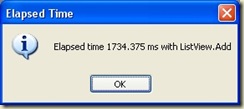Filling ListView control with Add method in VB.NET is fast enough when you are dealing with only a few items. Things get different when you have to insert hundreds or maybe a few thousands items to ListView control. In this case the user may experience a noticeable delay in the application.
The solution is to use AddRange method which is the fastest way to fill ListView control. Below is the comparison of these two methods.
Fill ListView control with Add method
The sample code uses ListView control in Details-mode with one column. The loop inserts 10 000 items to control. Timing method is simple and it is not meant to provide neither totally exact nor precise timing.
''' <summary> ''' Fill listview with Add method ''' </summary> ''' <param name="ListView1">ListView object</param> ''' <remarks></remarks> Public Sub FillListViewWithAdd(ByRef ListView1 As ListView) ' Dim StartTime As DateTime Dim Elapsed As Double Dim TempStr() As String Dim TempNode As ListViewItem Dim i As Integer ListView1.View = View.Details ListView1.Columns.Clear() ListView1.Columns.Add("Name", 180) ListView1.Items.Clear() ReDim TempStr(0) StartTime = System.DateTime.Now For i = 0 To 9999 TempStr(0) = "Name" & i.ToString TempNode = New ListViewItem(TempStr) TempNode.Tag = i.ToString ListView1.Items.Add(TempNode) Next i Elapsed = System.DateTime.Now.Subtract(StartTime).TotalMilliseconds MessageBox.Show("Elapsed time " & Elapsed.ToString & " ms with ListView.Add", _ "Elapsed Time", _ MessageBoxButtons.OK, _ MessageBoxIcon.Information) End Sub
And the result is:
Fill ListView control with AddRange method
The sample code is basically same as above. Only differences are storing first ListViewItems to array and after that using AddRange method to insert items to ListView control.
''' <summary> ''' Fill listview with AddRange method ''' </summary> ''' <param name="ListView1">ListView object</param> ''' <remarks></remarks> Public Sub FillListViewWithAddRange(ByRef ListView1 As ListView) ' Dim StartTime As DateTime Dim Elapsed As Double Dim TempStr() As String Dim TempNode As ListViewItem Dim TempArr() As ListViewItem Dim i As Integer ListView1.View = View.Details ListView1.Columns.Clear() ListView1.Columns.Add("Name", 180) ListView1.Items.Clear() ReDim TempStr(0) ReDim TempArr(9999) StartTime = System.DateTime.Now For i = 0 To 9999 TempStr(0) = "Name" & i.ToString TempNode = New ListViewItem(TempStr) TempNode.Tag = i.ToString TempArr(i) = TempNode Next i ListView1.Items.AddRange(TempArr) Elapsed = System.DateTime.Now.Subtract(StartTime).TotalMilliseconds MessageBox.Show("Elapsed time " & Elapsed.ToString & " ms with ListView.AddRange", _ "Elapsed Time", _ MessageBoxButtons.OK, _ MessageBoxIcon.Information) End Sub
And the result is:
Add method versus AddRange method
The conclusion is very clear. AddRange method offers the fastest way to fill ListView control. In the sample codes above the AddRange method was five times faster compared to Add method. This does not make Add method obsolete by any means. When you are dealing with only a few or a few hundreds of items, you may well use Add method.


4 comments:
Rather than using System.DateTime.Now you can use Stopwatch to track performance.
It is more accurate and directly provides the time required between Stopwatch.Start() and Stopwatch.Stop().
Thanks. Stopwatch class can be found in System.Diagnostics namespace in .NET 2.0 and later.
Thanx sooooooooooooooo much!!
GREAT!
Excellent find! This is probably due to the sorting involved - it is faster to do it in one shot.
Post a Comment